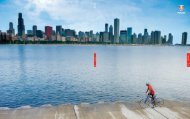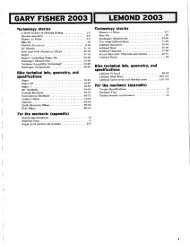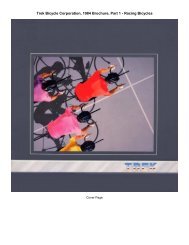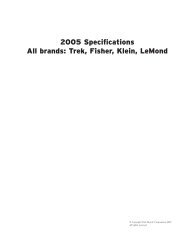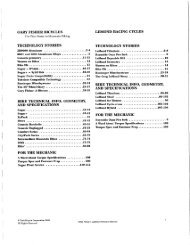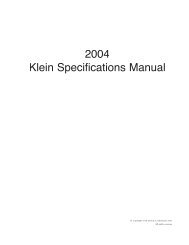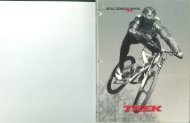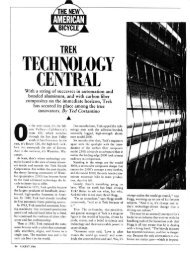TECHNOLOGY STORIES BIKE INFO, GEOMETRY ... - Vintage Trek
TECHNOLOGY STORIES BIKE INFO, GEOMETRY ... - Vintage Trek
TECHNOLOGY STORIES BIKE INFO, GEOMETRY ... - Vintage Trek
You also want an ePaper? Increase the reach of your titles
YUMPU automatically turns print PDFs into web optimized ePapers that Google loves.
Is aluminum a new material?<br />
It should be common knowledge that most modern<br />
aircraft use aluminum exclusively for their primary<br />
structures (internal frames and bulkheads) and 95% or<br />
better of their exterior surfaces, including load bearing<br />
skins. The aircraft industry has been using these alloys<br />
for several decades. The aircraft companies have picked<br />
aluminum because it offers the best combination of<br />
material properties and processing capability in order to<br />
create high performance, light weight, robust aircraft.<br />
So aluminum alloys have certainly proved their long<br />
term durability and high performance in the aircraft<br />
industry. The occasional failure that has occurred has<br />
typically been due to a design or manufacturing defect<br />
or improper maintenance.<br />
Doesn’t steel resist fatigue better than aluminum?<br />
Occasionally we hear fatigue failure erroneously<br />
described as similar to the result of bending a coat<br />
hanger back and forth. This example is not relevant to<br />
the durability or reliability of a bicycle frame. When<br />
you permanently deform the coat hanger you are yielding<br />
it. This has no relation to fatigue strength. Some of<br />
the highest fatigue strength materials (like carbon composite)<br />
will not take a significant permanent set, breaking<br />
instead at a high force level. So these extremely<br />
high fatigue strength fibers would rate near zero by the<br />
coat hanger test.<br />
A high strength steel alloy will exhibit a longer<br />
fatigue life at a high, fully reversing load level. But<br />
remember, these numbers always reflect performance<br />
for a unit volume. Steel weighs 3 times as much as<br />
aluminum for the same volume. In other words, if these<br />
statistics were based on weight instead of volume, steel<br />
would have to exhibit 3 times the fatigue strength of<br />
aluminum to be considered stronger, and it doesn’t.<br />
Steel is only the better material if you don’t care how<br />
much your bike weighs.<br />
What are the benefits of aluminum in bike frame construction?<br />
Aluminum is a great material to work with. It’s light<br />
weight, or more accurately, low density. One cubic inch<br />
weighs one tenth of a pound. Contrast that to steel,<br />
where the same cubic inch weighs three times that<br />
amount. You can use twice the volume of metal that<br />
a good steel frame uses and the steel frame will still<br />
weigh 50% more than an aluminum frame. And the<br />
lighter weight positively affects the ride quality.<br />
Aluminum provides a great ride, if you use it to its<br />
optimum. Aluminum’s low density and high formability<br />
allows a designer to tailor the stiffness of each part of<br />
the frame through tubing and joint design. Tube shaping<br />
and butting can make more difference in the ride of<br />
the bike than the material itself.<br />
Aluminum is very strong. It is possible to achieve<br />
significantly higher strength properties in the aluminum<br />
structure per weight than in steel. Part of this comes<br />
from the basic material properties. You can use more<br />
material, and more easily form the material, so you can<br />
put just the amount and shape needed into the bike.<br />
But the largest contributor to high strength is engineering<br />
and design. The low density and high formability<br />
of aluminum allows tubing with increased wall<br />
thickness, complex shapes and larger sections where we<br />
want to achieve high strength properties in the overall<br />
structure.<br />
2002 <strong>Trek</strong> Technical Manual<br />
Alpha aluminum<br />
Are all aluminum alloys basically the same?<br />
Some of the highest strength aluminum alloys, particularly<br />
in the 7000 series, have low elongation, or<br />
toughness, or resistance to crack propagation. This is<br />
important for overall strength and fatigue resistance.<br />
With alloys exhibiting higher toughness less material<br />
is needed to resist fatigue, and this can result in a<br />
lighter bike. Like with any bike frame material, good<br />
design and manufacturing is much more important<br />
than a small difference in a single mechanical property.<br />
What do the numbers mean?<br />
When we discuss aluminum alloys, we refer to a fourdigit<br />
number. This is the alloy name, based on the<br />
alloying materials in the aluminum. A metallurgy reference<br />
would explain precisely what elements are added<br />
to the aluminum in a specific percentage.<br />
The second part of describing aluminum alloys is the<br />
heat treatment or other strength enhancements which<br />
have been applied to the alloy. With some alloys,<br />
special heat treatments or work hardening are essential<br />
to achieve their maximum strength. Other aluminum<br />
alloys attain their maximum strength by simply cooling<br />
at room temperature, also known as ‘normalizing’.<br />
Since heat treatment adds extra steps to manufacturing,<br />
it adds cost. An oven large enough to handle bike<br />
frames also adds cost. 6061 aluminum requires heat<br />
treatment. 7005 is usually normalized.<br />
ALPHA NOMENCLATURE EXPLAINED-<br />
Alpha<br />
Proprietary <strong>Trek</strong> aluminum tubing, using 7005 or<br />
6061 T6 aluminum. These frames use special tubing<br />
diameters, wall thicknesses, designed by our engineering<br />
staff. Alpha frames are built by outside vendors<br />
to <strong>Trek</strong> specifications. They go through the full <strong>Trek</strong><br />
engineering process starting with design and including<br />
a full testing protocol. Some Alpha frames are<br />
built in Wisconsin, some are imported then painted<br />
and assembled in Wisconsin. Alpha tubesets are on the<br />
4000 series ATBs, 1000 series road bikes, Navigators,<br />
and some hybrids.<br />
Alpha ZX<br />
Like the Alpha frames, Alpha ZX is <strong>Trek</strong> designed<br />
aluminum tubing. However, Alpha ZX frames are built<br />
with 6061 T6 aluminum. <strong>Trek</strong>’s proprietary heat treating<br />
process enhances the Alpha ZX tensile strength,<br />
yield strength, and elongation making for a superior<br />
frame.<br />
Alpha ZX frames are all built and painted in<br />
Wisconsin. They are slightly lighter than the standard<br />
Alpha frames, and with the same durability, making<br />
them ideal for riders concerned with faster times.<br />
Alpha ZX tubesets are on 4000 series ATBs, and some<br />
hybrids.<br />
Alpha SL<br />
Alpha SL and SLR frames are also <strong>Trek</strong> designed<br />
tubes of 6061 T6. They are built and painted in<br />
Wisconsin. In addition, SL frames are use butted tubing<br />
to reduce weight and enhance the ride. <strong>Trek</strong>’s proprietary<br />
heat treating process enhances the Alpha SL<br />
tensile strength, yield strength, and elongation making<br />
for a superior frame.<br />
Alpha SL and SLR tubesets are on 6000 series ATBs,<br />
2000 series road bikes, XO-1, and Hilos.<br />
3




